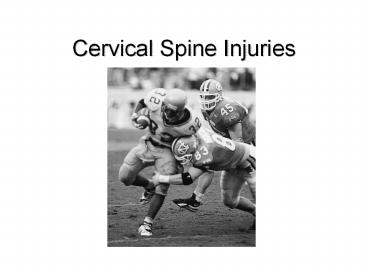Cervical Spine Injuries PowerPoint PPT Presentation
Title: Cervical Spine Injuries
1
Cervical Spine Injuries
2
The Cervical Spine
- Vertebrae
- 7 cervical
- 12 thoracic
- 5 lumbar
- 5 sacral
- 4 coccyx
3
Anatomy of Cervical Vertebrae
Odontoid Process (Dens) of Axis
Anterior Arch of Atlas
Superior Articular
Facet
Transverse Process
Transverse Foramen
C1-C2 Facet
Inferior Articular Process
Body of Axis
Posterior Arch of Atlas
Lamina
Bifid Spinous Process
4
Dermatomes
5
Cervical Sprain
- Facet Joint Injury
- Mechanism of Injury
- Generally the same mechanism as a strain
- More violent
- Involves a snapping of the head and neck
- Ligaments injured
- Signs and Symptoms
- Similar signs and symptoms to a strain
- Tenderness facet joints and ligaments
- Pain will usually arise the day after the trauma
- Muscle spasms
6
Cervical (Sprain)
- Management
- Severe injuries
- Activate EMS
- Refer to MD
- RICE for first 48-72 hours
- Bed rest if severe
- Rehabilitation
- Strengthening
- Restore ROM
- Review tackling techniques for football players
7
Brachial Plexus Injuries(Burner/Stinger)
- Mechanism of Injury
- Lateral flexion
- Result of
- Stretching of the brachial plexus or
- Compression of the brachial plexus
- Disrupts peripheral nerve function
8
Brachial Plexus Injury (Burner/Stinger)
- Signs and Symptoms
- Burning sensation
- Numbness and tingling from the shoulder into the
hand - Pain extending from the shoulder into the hand
- Some loss of function of the arm and hand for
several minutes - Dead arm feeling by athlete
- Symptoms rarely persist for several days
- Repeated injury can result in permanent damage
9
Brachial Plexus Neurapraxia (Burner/Stinger)
- Management
- Assessment by medical personnel
- Ice
- Rest
- Strengthening and stretching program
- Return to activity once signs and symptoms have
returned to normal - Padding to limit neck ROM during impact
10
Cervical Fractures
- Mechanism of Injury
- Usually axial load w/ some degree of cervical
flexion - Spearing
- Prevention
- Teach proper tackling technique
- (See what you hit)
11
Cervical Fractures
- Signs and Symptoms
- Neck point tenderness
- Restricted motion
- Cervical muscle spasm
- Cervical pain
- Pain in the chest and extremities
- Numbness in the trunk and or limbs
- Weakness in the trunk and/or limbs
- Loss of bladder and bowel control
- Management
- Activate EMS (911)
- Treat like an unconscious athlete
- Use extreme care
- X-ray and physician referral
- Transport with extreme caution
- Minimize movement of cervical spine
- Cervical extrication collar
- Spine Board
12
Cervical Dislocation
- Mechanism of Injury
- Usually violent flexion and rotation of the head
13
Cervical Dislocation
- Signs and Symptoms
- Considerable pain
- Numbness
- Weakness or paralysis
- Management
- Extreme care must be used
- Do not straighten athletes neck
- Activate EMS (911)
- More likely to cause spinal cord injury than a
fracture
14
Log Roll onto Spine Board
Stabilize Head and Neck
Lifting Spine Board
2b
1
5
5 Man Lift
Facemask Removal
2a
3
5
Strap to Board
Log Roll onto Spine Board
2b
4
5
15
Strengthening Exercises
- Initiated when near normal range has been
achieved - Should be performed pain free
- Exercise progression
- Isometric
- Isotonic exercises

